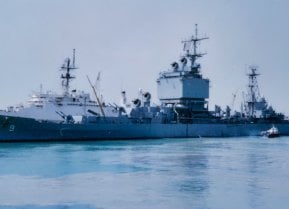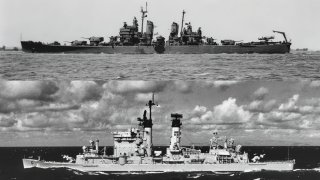Quick Facts: The U.S. Navy's Albany-Class Guided Missile Cruisers
The Albany-class guided missile cruisers, originating from the World War II-era Baltimore-class heavy cruisers, represented a significant transition in naval warfare towards missile dominance.
Summary: The Albany-class guided missile cruisers, originating from the World War II-era Baltimore-class heavy cruisers, represented a significant transition in naval warfare towards missile dominance. The transformation of three Baltimore-class ships into the Albany class marked an extensive conversion that stripped them down to their hulls and rebuilt them with high superstructures and heavy utilization of aluminum. These cruisers were equipped with advanced weapons systems for their time, including the Talos and Tartar missiles for surface-to-air engagements and ASROC and torpedoes for anti-submarine warfare.
From Heavy Guns to Missiles: The Evolution of the Albany-Class Cruisers
The Albany-class experimental guided missile cruiser began as a conversion from Baltimore-class heavy cruisers. Three vessels were fitted to form the Albany-class, which was distinct for its heavy use of aluminum.
The Baltimore-class was the first U.S. vessel built after the limitations of the London Naval Treaty were lifted, and these heavy cruisers saw action during World War II. Fourteen total vessels were built, making the Baltimore the most numerous of any heavy cruiser class.
The Baltimore was renowned for its speed and firepower. The vessels were fast enough to protect aircraft carriers from air attack. With their 8-inch primary guns and 5-inch secondary guns, the Baltimore-class ships could also contribute to bombardments supporting amphibious landings.
The Baltimore was not cheap, costing $40 million per unit. The 14 vessels were pumped out between 1941 and 1945, when the U.S. economy was fully mobilized to assist in the war effort. When fully loaded, the ship displaced 17,000 tons. It measured 664 feet along the water line, 70 feet at the beam and 112 feet tall. The Baltimore’s power plant included four Babcock & Wilcox boilers, four screws, and four steam turbine sets, and it could propel the vessel at 33 knots.
To operate, the Baltimore required a complement of 1,085 sailors and 61 officers. Two life rafts were on board, and remarkably, so were two aircraft catapults, which were set along the vessel’s side edge on the aft deck.
On the deck was a sliding hatchway beneath which was a hangar that could hold up to four aircraft – the Vought OS2U Kingfisher, and later the Curtiss SC-1 Seahawk. The propeller-driven planes were deployed for recon, anti-submarine operations, and rescue missions. The planes would be launched along the side edge catapults. They would land in the sea near the ship before being crane-hoisted back onto the deck. The idea was fairly novel, and of course, today the only U.S. Navy vessels with aircraft catapults are aircraft carriers.
The Baltimore-class would be decommissioned gradually after the war ended. But for several of the vessels, decommissioning was not the end of the line. Instead, the Navy had a set of experiments in mind.
The Albany-Class
The Albany class consisted of three vessels: the Albany, the Chicago, and the Columbus. Each was commissioned between late 1962 and mid-1964.
The conversion was extensive. The ships were stripped all the way down to their hulls. The armament was removed, and so was the superstructure. Once converted, the ships were distinct for their unusually high superstructures and their extensive use of aluminum.
The class carried a variety of weapons systems that were very advanced at the time, including the Mk 77 missile fire control system, with four AN/SPG-49 fire-control radars and two Mk 12 twin launchers for the 104 Talos long-range surface-to-air missiles. One launcher was kept forward, while another was kept aft.
The Albany also carried 84 relatively shorter-ranged Tartar missiles that could be launched from two Mk 11 twin launchers. One Mk 11 was located to the port side, and one to the starboard side of the vessel’s superstructure. A Mk 74 fire-control system was used to control the Tartar missiles, relying on four AN/SPG-51 fire-control radars. Initially, the Navy hoped to install eight Polaris missiles, but these plans were canceled in 1959.
To assist in anti-submarine operations, the Albany carried one eight-cell Mk 112 “matchbox” Anti-Submarine Rocket launcher and two triple Mk 32 torpedo tubes for the MK 46 ASW torpedo.
Originally, the Albany-class vessels were converted into all-missile warships – without any form of naval gun. But eventually, two open-mount Mk 24 5-inch-38 caliber guns were installed on the port and starboard sides.
The three vessels served extensively during the 1960s and 1970s. The ships were used in the Pacific, Atlantic, and Mediterranean. The Columbus was decommissioned and sold for scrap in 1976. The Albany and the Chicago remained on active duty until 1980, when they were finally decommissioned. They were sold for scrap in 1990.
About the Author: Harrison Kass
Harrison Kass is a defense and national security writer with over 1,000 total pieces on issues involving global affairs. An attorney, pilot, guitarist, and minor pro hockey player, Harrison joined the US Air Force as a Pilot Trainee but was medically discharged. Harrison holds a BA from Lake Forest College, a JD from the University of Oregon, and an MA from New York University. Harrison listens to Dokken.
Image Credit and Caption: Two views of the U.S. Navy cruiser USS Chicago, as built and after her conversion to a guided missile cruiser. Upper view: USS Chicago (CA-136) as a Baltimore-class heavy cruiser off the Philadelphia Naval Shipyard, Pennsylvania (USA), on 7 May 1945. Between 1959 and 1964, Chicago was rebuilt at the San Francisco Naval Shipyard, California (USA), leaving virtually only the hull. The complete superstructure and armament was replaced. Lower view: USS Chicago (CG-11) as an Albany-class guided missile cruiser underway in the Pacific Ocean during exercise "Valiant Heritage" on 2 February 1976.


